ВУЗ: Не указан
Категория: Не указан
Дисциплина: Не указана
Добавлен: 01.04.2021
Просмотров: 1531
Скачиваний: 7
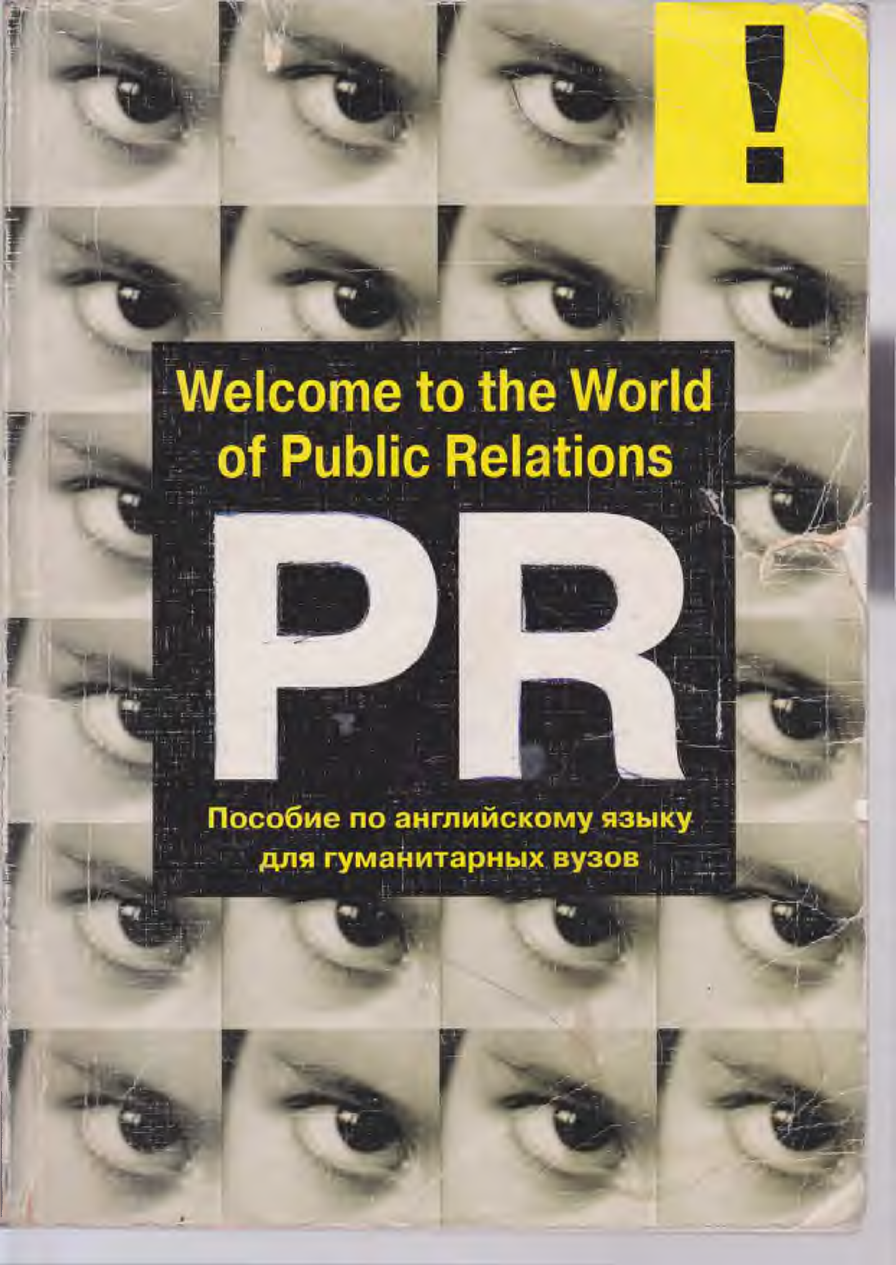
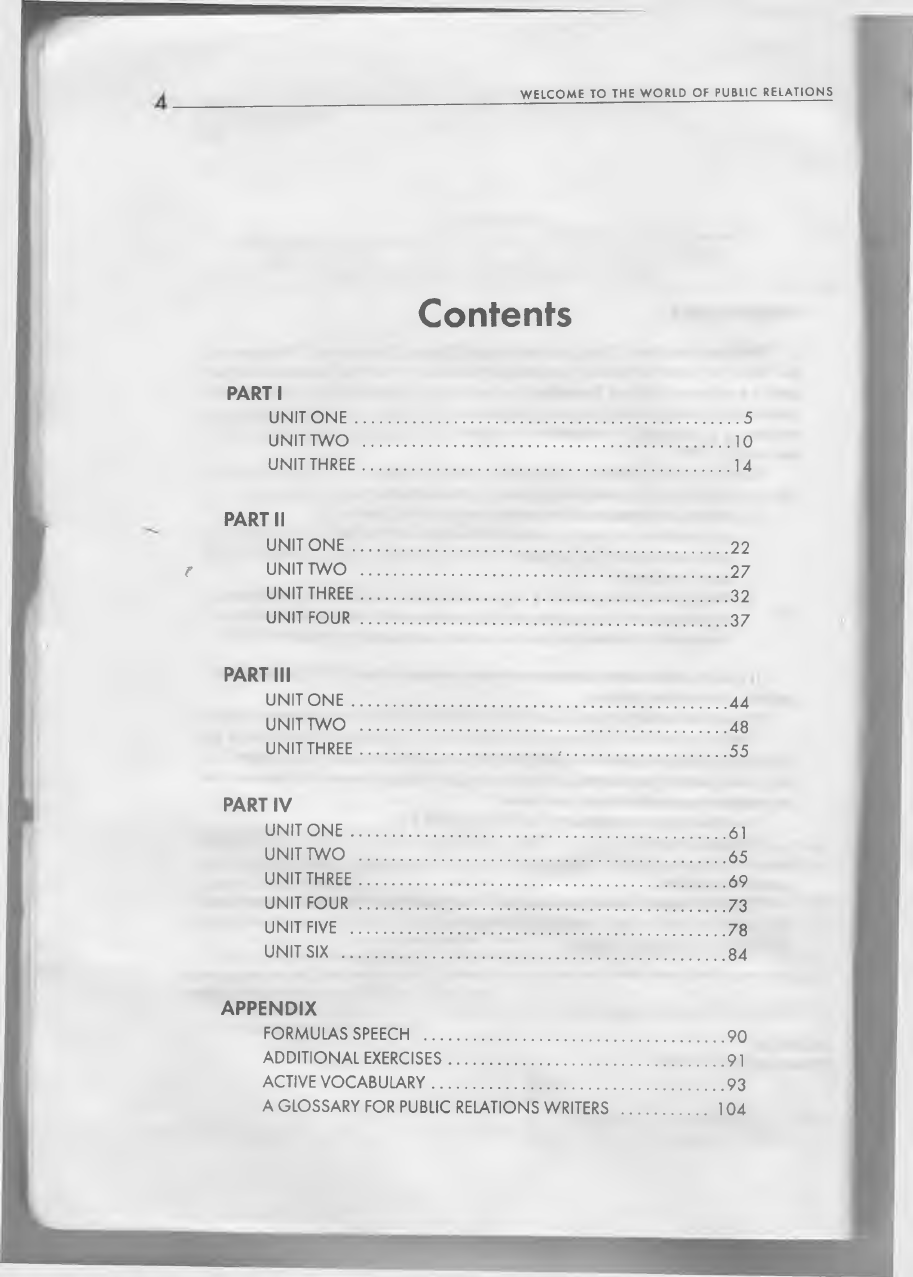
W E L C O M E T O T H E W O R L D O F P U B L I C R E L A T I O N S
Contents
PARTI
PART II
PART III
PART IV
APPENDIX
ADDITIONAL EXERCISES............................................................................. 91
A GLOSSARY FOR PUBLIC RELATIONS WRITERS ........................ 104
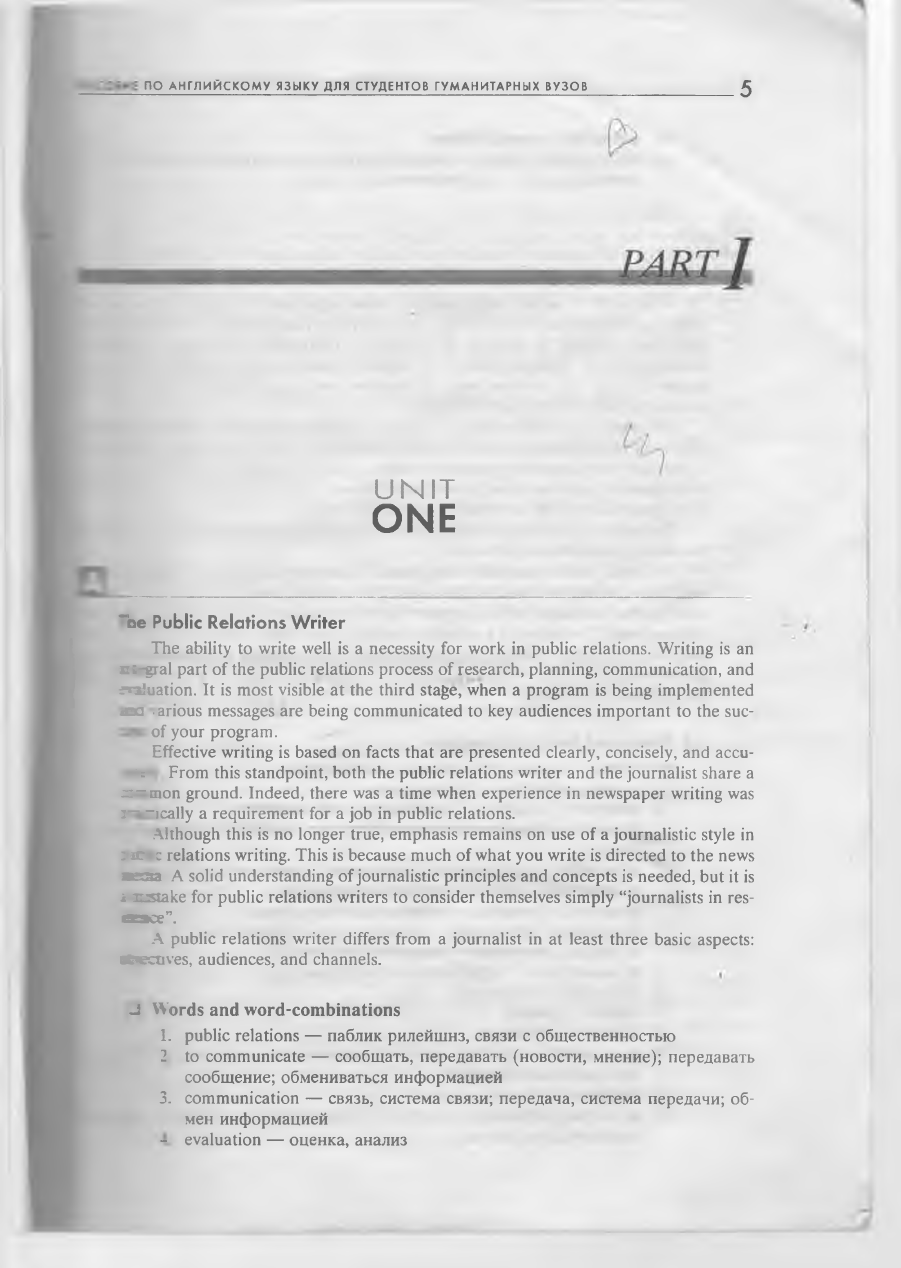
П О А Н Г Л И Й С К О М У Я З Ы К У
д л я
с т у д е н т о в
г у м а н и т а р н ы х
в у з о в
5
U N I T
ONE
"He Public Relations Writer
The ability to write well is a necessity for work in public relations. Writing is an
r:-g ral part of the public relations process of research, planning, communication, and
jr^uation. It is most visible at the third stage, when a program is being implemented
XCC
• arious messages are being communicated to key audiences important to the suc-
of your program.
Effective writing is based on facts that are presented clearly, concisely, and accu-
‘ r
From this standpoint, both the public relations writer and the journalist share a
z z ~ z
\on ground. Indeed, there was a time when experience in newspaper writing was
: —~:cally a requirement for a job in public relations.
Although this is no longer true, emphasis remains on use of a journalistic style in
: i t : relations writing. This is because much of what you write is directed to the news
iiecia A solid understanding of journalistic principles and concepts is needed, but it is
i
msta.
ke for public relations writers to consider themselves simply “journalists in res-
CEEce”.
A public relations writer differs from a journalist in at least three basic aspects:
*r*ecti ves, audiences, and channels.
J Words and word-combinations
1. public relations — паблик рилейшнз, связи с общественностью
1 to communicate — сообщать, передавать (новости, мнение); передавать
сообщение; обмениваться информацией
5. communication — связь, система связи; передача, система передачи; об
мен информацией
- evaluation — оценка, анализ
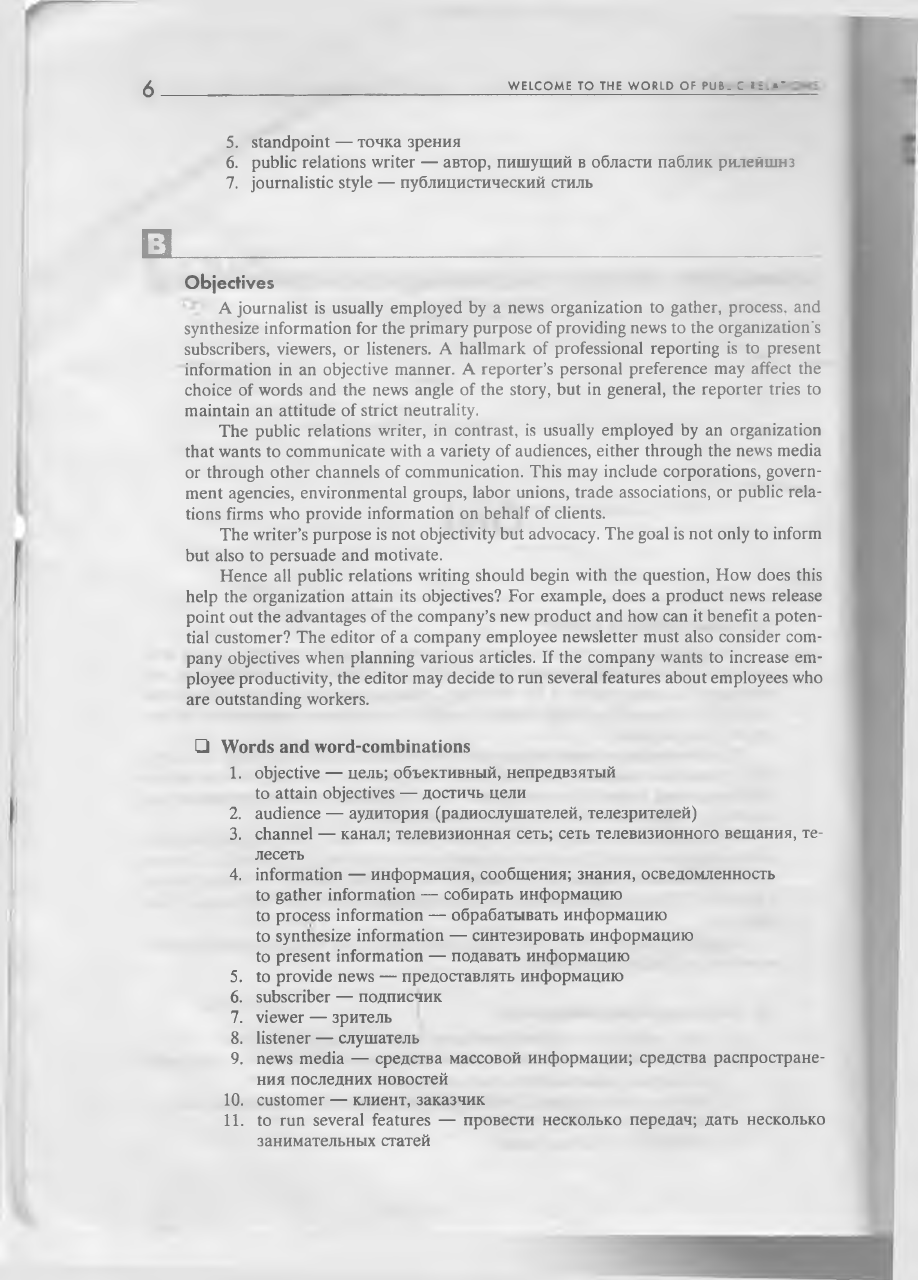
6
W E L C O M E T O T H E W O R L D O F P U B . С ; = . * *
5. standpoint — точка зрения
6. public relations writer — автор, пишущий в области паблик рилейшнз
7. journalistic style — публицистический стиль
0 1
Objectives
A journalist is usually employed by a news organization to gather, process, and
synthesize information for the primary purpose of providing news to the organization's
subscribers, viewers, or listeners. A hallmark of professional reporting is to present
information in an objective manner. A reporter’s personal preference may affect the
choice of words and the news angle of the story, but in general, the reporter tries to
maintain an attitude of strict neutrality.
The public relations writer, in contrast, is usually employed by an organization
that wants to communicate with a variety of audiences, either through the news media
or through other channels of communication. This may include corporations, govern
ment agencies, environmental groups, labor unions, trade associations, or public rela
tions firms who provide information on behalf of clients.
The writer’s purpose is not objectivity but advocacy. The goal is not only to inform
but also to persuade and motivate.
Hence all public relations writing should begin with the question, How does this
help the organization attain its objectives? For example, does a product news release
point out the advantages of the company’s new product and how can it benefit a poten
tial customer? The editor of a company employee newsletter must also consider com
pany objectives when planning various articles. If the company wants to increase em
ployee productivity, the editor may decide to run several features about employees who
are outstanding workers.
□ Words and word-combinations
1. objective — цель; объективный, непредвзятый
to attain objectives — достичь цели
2. audience — аудитория (радиослушателей, телезрителей)
3. channel — канал; телевизионная сеть; сеть телевизионного вещания, те
лесеть
4. information — информация, сообщения; знания, осведомленность
to gather information — собирать информацию
to process information — обрабатывать информацию
to synthesize information — синтезировать информацию
to present information — подавать информацию
5. to provide news — предоставлять информацию
6. subscriber — подписчик
7. viewer — зритель
8. listener — слушатель
9. news media — средства массовой информации; средства распростране
ния последних новостей
10. customer — клиент, заказчик
И . to run several features — провести несколько передач; дать несколько
занимательных статей
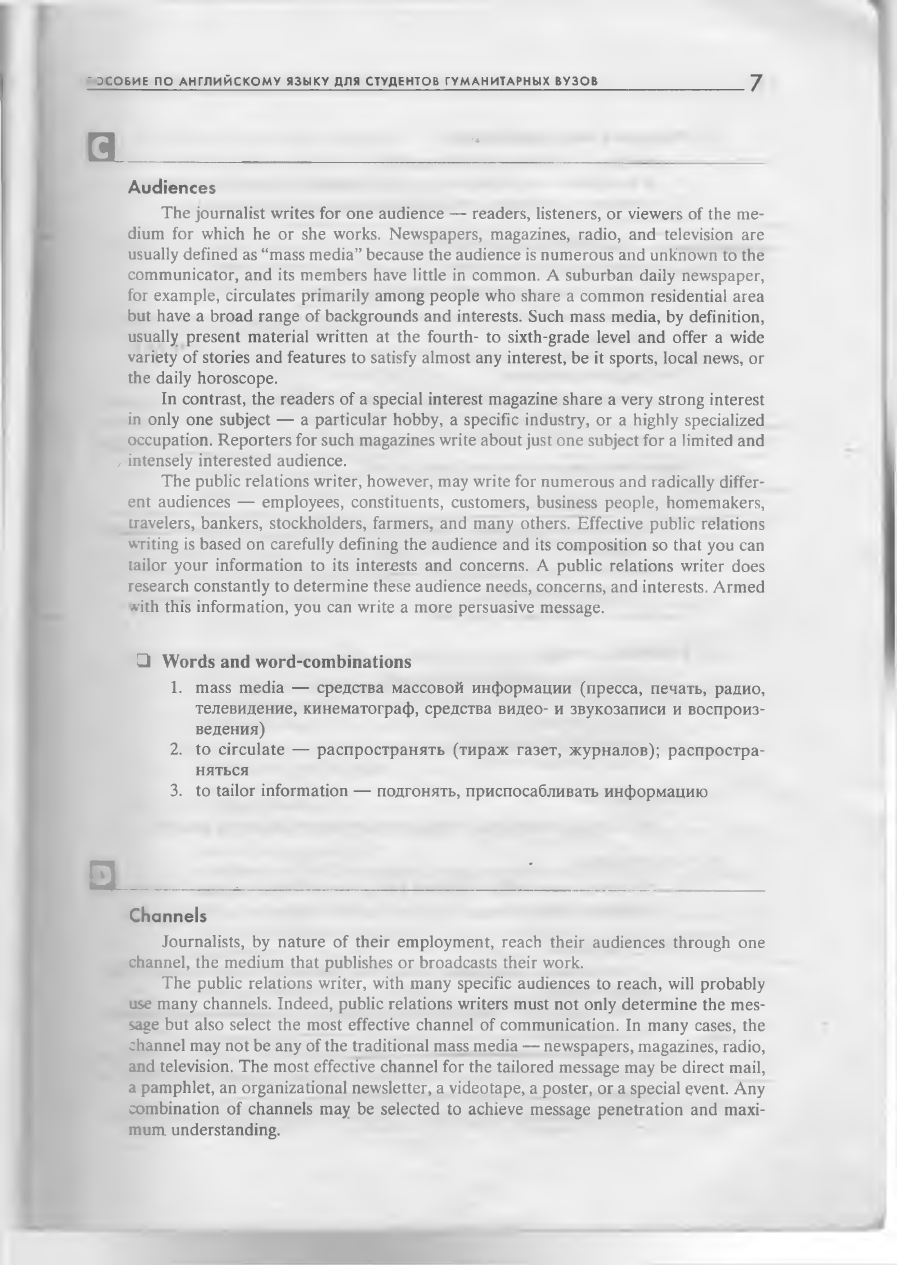
~ С С О Б И Е П О А Н Г Л И Й С К О М У Я З Ы К У Д Л Я С Т У Д Е Н Т О В Г У М А Н И Т А Р Н Ы Х В У З О В
7
а
_______________________ -
Audiences
The journalist writes for one audience — readers, listeners, or viewers of the me
dium for which he or she works. Newspapers, magazines, radio, and television are
usually defined as “mass media” because the audience is numerous and unknown to the
communicator, and its members have little in common. A suburban daily newspaper,
for example, circulates primarily among people who share a common residential area
but have a broad range of backgrounds and interests. Such mass media, by definition,
usually present material written at the fourth- to sixth-grade level and offer a wide
variety of stories and features to satisfy almost any interest, be it sports, local news, or
the daily horoscope.
In contrast, the readers of a special interest magazine share a very strong interest
in only one subject — a particular hobby, a specific industry, or a highly specialized
occupation. Reporters for such magazines write about just one subject for a limited and
/ intensely interested audience.
The public relations writer, however, may write for numerous and radically differ
ent audiences — employees, constituents, customers, business people, homemakers,
travelers, bankers, stockholders, farmers, and many others. Effective public relations
writing is based on carefully defining the audience and its composition so that you can
tailor your information to its interests and concerns. A public relations writer does
research constantly to determine these audience needs, concerns, and interests. Armed
•vith this information, you can write a more persuasive message.
□ Words and word-combinations
1. mass media — средства массовой информации (пресса, печать, радио,
телевидение, кинематограф, средства видео- и звукозаписи и воспроиз
ведения)
2. to circulate — распространять (тираж газет, журналов); распростра
няться
3. to tailor information — подгонять, приспосабливать информацию
□
.____________________________________ :____________________ ___ _
Channels
Journalists, by nature of their employment, reach their audiences through one
channel, the medium that publishes or broadcasts their work.
The public relations writer, with many specific audiences to reach, will probably
use many channels. Indeed, public relations writers must not only determine the mes
sage but also select the most effective channel of communication. In many cases, the
channel may not be any of the traditional mass media — newspapers, magazines, radio,
and television. The most effective channel for the tailored message may be direct mail,
a pamphlet, an organizational newsletter, a videotape, a poster, or a special event. Any
combination of channels may be selected to achieve message penetration and maxi
mum understanding.